Kunsthaus Tacheles
|
Facade of Kunsthaus Tacheles at Oranienburger Straße | |
| Established | 1990 |
|---|---|
| Location |
Oranienburger Straße 54, 56a Berlin, Germany |
| Type | Art gallery, Art house[1] |
| Website | Official website |
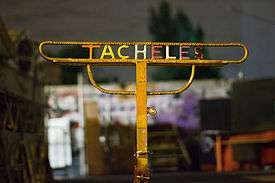
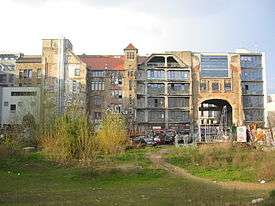
The Kunsthaus Tacheles (Art House Tacheles) was an art center in Berlin, Germany, a large (9,000 m2 (97,000 sq ft)) building and sculpture park on Oranienburger Straße in the district known as Mitte. Huge, colorful graffiti-style murals are painted on the exterior walls, and modern art sculptures are featured inside. The building houses an artists collective which is threatened with eviction.
Originally called Friedrichsstadtpassagen, it was built as a department store in the Jewish quarter (Scheunenviertel) of Berlin, next to the synagogue.[2] Serving as a Nazi prison for a short while, it was later partially demolished. After the Berlin Wall had come down, it was taken over by artists, who called it Tacheles, Yiddish for "straight talking".[2] The building contained studios and workshops, a nightclub, and a cinema. Outside, the garden featured an open-air exhibition of metal sculptures as well as galleries and studios for sculptors and painters. A part of the garden still remains open to the public.
History
The house was finally closed on September 4, 2012. Tacheles Metallwerkstatt, the sculpture park, was open until March 2013, when the financial group Nordbank decided to make money out of it.
A developer called the Fundus Group bought the site from the Berlin government in the mid-1990s. Because it was in no hurry to do anything with the building, it gave the artists a 10-year lease in 1998 at a nominal rent of 1 DM (about 0.50 EUR).
This contract was then extended but expired at the end of 2009, at which point the artists again became squatters. By this time, the Fundus Group had become insolvent, so the Hamburg-based HSH Nordbank, to which the Fundus Group owed money, decided to sell the property.
There was a division inside the Tacheles. ‘Upstairs' lived the artists from the coterie around organizer Martin Reiter, chairman of Tacheles e.V., the association that was formed in 1994 but went bankrupt in 2010. ‘Downstairs' around 20 businesses like High End Kino 54 and Café Zapata, together with the Johannishof artists not represented by the e.V., formed Gruppe Tacheles.
The Nordbank offered 1 million euros to the ‘downstairs' group in order to leave, and they accepted it on 5 April 2011.
Tim Africa, the spokesman of the ‘downstairs' group, said they planned to use the money to settle outstanding costs such as legal fees and, with the money left over, hopefully start a new art project. However, he refused to say which individuals had actually received the money. Furthermore, he said the money had come via a Berlin law firm from an anonymous source.
A spokeswoman for HSH Nordbank said it had not paid the 1 million euros to the downstairs group and did not know who — if anyone — was behind the money.
Friedrichstraßenpassage
The building was constructed over the course of 15 months in 1907 and 1908 under the watch of the imperial building office (kaiserlicher Baurat) Franz Ahrens. The building complex stretched from Friedrichstraße to Oranienburger Straße. The shopping arcade had entrances from both sides and served to connect the two main thoroughfares. The Friedrichstraßenpassage was the second largest of its kind in the city and the only remaining example in Europe of this type of architecture. The construction expenses totaled approximately 7 million German marks.
The five-story building was made of reinforced concrete with a colossal ribbed dome. The façade was built to be dependent upon this concrete frame. There were several small businesses on both sides of the large covered arcade. The building is typically treated as an example of early Modern architecture but exhibits aspects of both Classic and Gothic styles. The complex also housed its own pneumatic tube system for sending mail and materials within the building.
A group of individual shareholders hoped to establish a market advantage by capitalizing on a common location. The concept meant that stores would not be strictly separated from one another, but would instead be allowed to overlap. This was enabled by the existence of a central point-of-sale terminal, where all customers would pay for their goods. But a mere 6 months after its opening the passage had to file for bankruptcy in August 1908. The complex was then rented by Wolf Wertheim, who in 1909 opened a new department store, which operated until 1914. The building was auctioned off shortly before World War I.
It is unclear how the building was used between 1914 and 1924. In 1924, among other additions to the building, a deep cellar was built. This cellar still exists today and is also known as the Tresorraum. The height of the ceiling in the passage was lowered to that of the stores, which changed the appearance of the building completely.
Haus der Technik
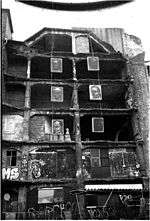
After 1928 the building was used as a show room by the Allgemeine Elektrizitäts-Gesellschaft (General Electric Company). It was renamed Haus der Technik by the proprietor, the Berliner Commerz- und Privatbank. The AEG used the space to display products and advise customers. The former AEG show room, located at Luisenstraße 35, had been destroyed by a fire on September 15, 1927. The new space covered over 113,000 sq ft (10,500 sq. meters) and used 20 large display cases. One of the first German television transmissions took place here during the 1930s.
Use by the NSDAP
In the early 1930s, the building was increasingly used by the National Socialist German Workers' Party (Nazi) party members. In the mid-1930s, the German Workers Front established offices for Gau Kurmark and became owners of the building in 1941. At the same time it became the central office for the SS.
In 1943 the skylights were closed and the corresponding ridge turrets removed, so that French war prisoners could be held in the attic. During the Battle of Berlin the second cellar was flooded by the Nazis and remains underwater today. The building was heavily damaged during World War II, though a large portion of it survived intact.
Use in the GDR
In 1948 the building was taken over by the Free German Trade Union Federation (FDGB) and deteriorated over the course of the next several years. Various retailers and craft businesses temporarily moved into the ruins, especially on the Friedrichstraße side. The German Travel Agency used the repaired passage section and several floors above ground. Among others, there was an artists' school, a technical school for foreign trade and economics, and office spaces for RFT (Rundfunk- und Fernmelde-Technik), a company dealing with radio and transmission technology. The cellar was used by the National People's Army.
The movie theater Camera was located in the Friedrichstraße gateway area, but was forced to leave in 1958 due to the worsening condition of the building. The presentation hall was dismantled, but was later reopened under the name OTL (Oranienburger Tor Lichtspiele). During the reconstruction work the facade was partially changed and a lobby area was built to house cash registers and checkout aisles. The roof was also rebuilt. This created the current entryway. The movie theater is still used today as a theater area, and after further reconstruction in 1972, it was renamed Camera.
Partial demolition
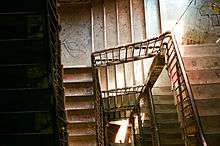
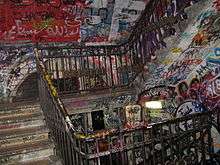
Though having suffered only moderate damage during World War II, the building was slated to be demolished as a result of two engineering opinions from 1969 and 1977; it had not once been renovated, despite relatively continuous and intensive use. A new street was planned on the site and would have created a shortcut between Oranienburger Straße and Friedrichstraße.
The demolition began in 1980. The dome was torn down and the movie theater closed. The remaining portions of the building were scheduled to be demolished in April 1990.
Artists' Initiative Tacheles
On February 13, 1990, two months before the planned demolition, the group Künstlerinitative Tacheles occupied the building. The group tried to prevent the demolition through discussions with the building management in Berlin-Mitte, which was legally responsible for the complex, by registering the building as an historic place. The planned demolition was not delayed however, until the group managed to get the Berlin Round Table to issue a last-minute injunction.
The artists' initiative had a new engineering survey done to evaluate the building's structural integrity. The study found that the building was in surprisingly good shape, and it was named a historic landmark shortly thereafter. Its status was officially recognized after a second survey done in February 1992.
In the beginning the centre was run by well-known curator Jochen Sandig who expanded the building considerably. In its early days, Tacheles provided both housing and work space for its artist residents. In 1991, the associated housing burnt down, and there was considerable suspicion that the fire was started deliberately in order to pave the way for a new art centre. Among the early exhibitors were artist Mark Divo, sculptors the Mutoid Waste Company, musicians Spiral Tribe, theatre group DNTT, performance artist Lennie Lee, dancer/ choreographer Sasha Waltz, RA.M.M. Theater, and many others.
There was an appreciable amount of disagreement among the East German and West German artists due to their conflicting views and concepts for the space. In the meantime, however, Tacheles has become a central part of the art, activist, exhibition and communication scenes in Berlin, and is officially registered as Tacheles, e. V.. In 1996 and 1997, politicians, sociologists, architects, and artists discussed the preservation and future use of the complex at Metropolis Berlin, Hochgeschwindigkeitsarchitektur (Metropolis Berlin, High Speed Architecture).
Use until 2011
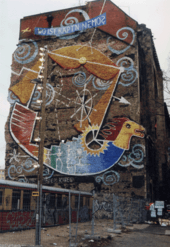
The building was painted in bright colors and a large courtyard behind the building holds several sculptures erected using rubble, debris, vehicles and other objects. It became an art centre with a cafe, cinema, performance space, workshops and exhibition space.
Tacheles provided inspiration for a scene in the German film Good Bye Lenin!, according to commentary by director Wolfgang Becker on the US DVD release.
The lease with the property owner expired at the end of 2008 and the future of the art centre became uncertain.
Recent time
On 4 April 2011 the owner HSH Nordbank scheduled an eviction, but it was not carried out. Instead, on the next day, the gastronomy and cinema left the building peacefully in return for a payment of 1 Million Euros from an anonymous source.[3] Eighty artists vowed to stay on with their ateliers and metal workshops. One week later, the sequestrator ordered an almost 3 m tall wall to be built, separating the Oranienburger Straße from the building's courtyard. The future concept for the building remains undecided.[4]
Present time
On September 4, 2012, the remaining 40-60 artists left peacefully, after pressure from the owner - after 22 years.[5] The Metallwerkstatt is still existing and fighting against eviction.
Several artists and programmers created a Tacheles 3D online art gallery, to open up new rooms for the Tacheles artists, and to continue the spirit of Tacheles online.[6] The association Artprotacheles aims at expanding the idea of Tacheles through Mobile Atelier Projects and has already realised the first one in Berlin Friedrichshain.
Gallery
See also
References
- ↑ Article on Goethe-Institut website
- 1 2 Tacheles Art House battles with banks for survival
- ↑ "Art icon Tacheles shrinks after €1-million payout". The Local. 5 April 2011.
- ↑ "Tacheles wird eingemauert". taz (in German). 12 April 2011.
- ↑ Authorities shut Berlin's iconic Tacheles arts squat
- ↑ Tacheles 3D online art gallery
External links
| Wikimedia Commons has media related to Kunsthaus Tacheles. |
- Tacheles official website
- ArtProTacheles
- Arda Metallwerkstatt Tacheles
- Pictures and History
- Cafe Zapata
- Artist's website
- Lennie Lee
- Klezmer goes Rock, Jazz, HipHop!
- Exhibitions
- Film events
- Flickr Photos Tagged With Tacheles
- Tacheles 3D online art gallery
- Tacheles Photo Documentary
- From Tacheles to Berlin Affordable Art/Klassenfeind Gallery
Coordinates: 52°31′32″N 13°23′19″E / 52.52556°N 13.38861°E













